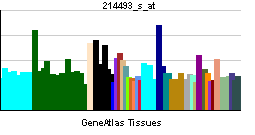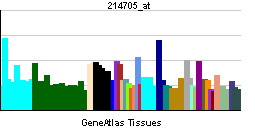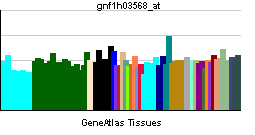INADL
| InaD-like (Drosophila) | |||||||||||||
|---|---|---|---|---|---|---|---|---|---|---|---|---|---|
 PDB rendering based on 2d92. | |||||||||||||
| |||||||||||||
| Identifiers | |||||||||||||
| Symbols | INADL ; Cipp; FLJ26982; PATJ | ||||||||||||
| External IDs | Template:OMIM5 Template:MGI HomoloGene: 72199 | ||||||||||||
| |||||||||||||
| RNA expression pattern | |||||||||||||
 | |||||||||||||
 | |||||||||||||
 | |||||||||||||
| More reference expression data | |||||||||||||
| Orthologs | |||||||||||||
| Template:GNF Ortholog box | |||||||||||||
| Species | Human | Mouse | |||||||||||
| Entrez | n/a | n/a | |||||||||||
| Ensembl | n/a | n/a | |||||||||||
| UniProt | n/a | n/a | |||||||||||
| RefSeq (mRNA) | n/a | n/a | |||||||||||
| RefSeq (protein) | n/a | n/a | |||||||||||
| Location (UCSC) | n/a | n/a | |||||||||||
| PubMed search | n/a | n/a | |||||||||||
InaD-like (Drosophila), also known as INADL, is a human gene.[1]
This gene encodes a protein with multiple PDZ domains. PDZ domains mediate protein-protein interactions, and proteins with multiple PDZ domains often organize multimeric complexes at the plasma membrane. This protein localizes to tight junctions and to the apical membrane of epithelial cells. A similar protein in Drosophila is a scaffolding protein which tethers several members of a multimeric signaling complex in photoreceptors.[1]
References
Further reading
- Fanning AS, Anderson JM (1999). "PDZ domains: fundamental building blocks in the organization of protein complexes at the plasma membrane". J. Clin. Invest. 103 (6): 767–72. PMID 10079096.
- Lennon G, Auffray C, Polymeropoulos M, Soares MB (1996). "The I.M.A.G.E. Consortium: an integrated molecular analysis of genomes and their expression". Genomics. 33 (1): 151–2. doi:10.1006/geno.1996.0177. PMID 8617505.
- Philipp S, Flockerzi V (1997). "Molecular characterization of a novel human PDZ domain protein with homology to INAD from Drosophila melanogaster". FEBS Lett. 413 (2): 243–8. PMID 9280290.
- Kurschner C, Mermelstein PG, Holden WT, Surmeier DJ (1998). "CIPP, a novel multivalent PDZ domain protein, selectively interacts with Kir4.0 family members, NMDA receptor subunits, neurexins, and neuroligins". Mol. Cell. Neurosci. 11 (3): 161–72. doi:10.1006/mcne.1998.0679. PMID 9647694.
- Soejima H, Kawamoto S, Akai J; et al. (2001). "Isolation of novel heart-specific genes using the BodyMap database". Genomics. 74 (1): 115–20. doi:10.1006/geno.2001.6527. PMID 11374908.
- Vaccaro P, Brannetti B, Montecchi-Palazzi L; et al. (2001). "Distinct binding specificity of the multiple PDZ domains of INADL, a human protein with homology to INAD from Drosophila melanogaster". J. Biol. Chem. 276 (45): 42122–30. doi:10.1074/jbc.M104208200. PMID 11509564.
- Anzai N, Deval E, Schaefer L; et al. (2002). "The multivalent PDZ domain-containing protein CIPP is a partner of acid-sensing ion channel 3 in sensory neurons". J. Biol. Chem. 277 (19): 16655–61. doi:10.1074/jbc.M201087200. PMID 11872753.
- Roh MH, Makarova O, Liu CJ; et al. (2002). "The Maguk protein, Pals1, functions as an adapter, linking mammalian homologues of Crumbs and Discs Lost". J. Cell Biol. 157 (1): 161–72. doi:10.1083/jcb.200109010. PMID 11927608.
- Lemmers C, Médina E, Delgrossi MH; et al. (2002). "hINADl/PATJ, a homolog of discs lost, interacts with crumbs and localizes to tight junctions in human epithelial cells". J. Biol. Chem. 277 (28): 25408–15. doi:10.1074/jbc.M202196200. PMID 11964389.
- Roh MH, Liu CJ, Laurinec S, Margolis B (2002). "The carboxyl terminus of zona occludens-3 binds and recruits a mammalian homologue of discs lost to tight junctions". J. Biol. Chem. 277 (30): 27501–9. doi:10.1074/jbc.M201177200. PMID 12021270.
- Strausberg RL, Feingold EA, Grouse LH; et al. (2003). "Generation and initial analysis of more than 15,000 full-length human and mouse cDNA sequences". Proc. Natl. Acad. Sci. U.S.A. 99 (26): 16899–903. doi:10.1073/pnas.242603899. PMID 12477932.
- Makarova O, Roh MH, Liu CJ; et al. (2003). "Mammalian Crumbs3 is a small transmembrane protein linked to protein associated with Lin-7 (Pals1)". Gene. 302 (1–2): 21–9. PMID 12527193.
- Roh MH, Fan S, Liu CJ, Margolis B (2004). "The Crumbs3-Pals1 complex participates in the establishment of polarity in mammalian epithelial cells". J. Cell. Sci. 116 (Pt 14): 2895–906. doi:10.1242/jcs.00500. PMID 12771187.
- Li Y, Karnak D, Demeler B; et al. (2005). "Structural basis for L27 domain-mediated assembly of signaling and cell polarity complexes". EMBO J. 23 (14): 2723–33. doi:10.1038/sj.emboj.7600294. PMID 15241471.
- Gerhard DS, Wagner L, Feingold EA; et al. (2004). "The status, quality, and expansion of the NIH full-length cDNA project: the Mammalian Gene Collection (MGC)". Genome Res. 14 (10B): 2121–7. doi:10.1101/gr.2596504. PMID 15489334.
- Michel D, Arsanto JP, Massey-Harroche D; et al. (2005). "PATJ connects and stabilizes apical and lateral components of tight junctions in human intestinal cells". J. Cell. Sci. 118 (Pt 17): 4049–57. doi:10.1242/jcs.02528. PMID 16129888.
- Stiffler MA, Grantcharova VP, Sevecka M, MacBeath G (2007). "Uncovering quantitative protein interaction networks for mouse PDZ domains using protein microarrays". J. Am. Chem. Soc. 128 (17): 5913–22. doi:10.1021/ja060943h. PMID 16637659.
- Wells CD, Fawcett JP, Traweger A; et al. (2006). "A Rich1/Amot complex regulates the Cdc42 GTPase and apical-polarity proteins in epithelial cells". Cell. 125 (3): 535–48. doi:10.1016/j.cell.2006.02.045. PMID 16678097.
- Gregory SG, Barlow KF, McLay KE; et al. (2006). "The DNA sequence and biological annotation of human chromosome 1". Nature. 441 (7091): 315–21. doi:10.1038/nature04727. PMID 16710414.
| This protein-related article is a stub. You can help Wikipedia by expanding it. |